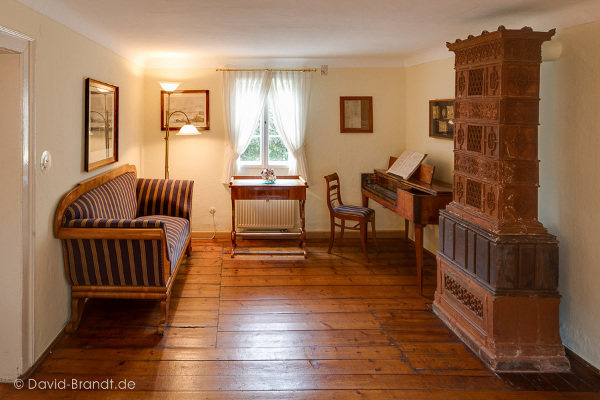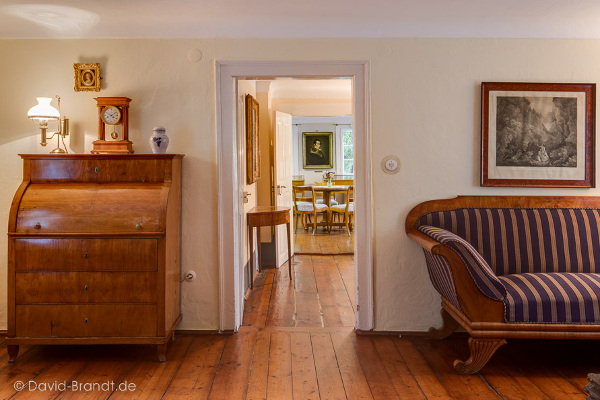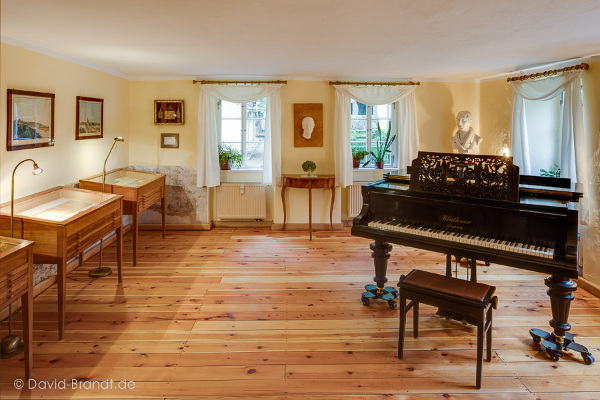




Dresdner Straße 44
01326 Dresden
Telefon/Fax +49.351.2618234
Web: www.museen-dresden.de
E-Mail: romy.donath@museen-dresden.de
„Oh Hosterwitz, oh Ruhe!“ Für einen ausgiebigen Musikspaziergang bietet sich ein Besuch des Carl-Maria-vonWeber-Museums in Dresden-Hosterwitz an. Dieses typisch sächsische Winzerhaus entdeckten der Komponist und seine Frau auf einem Spaziergang im Frühjahr 1818.
Hier verlebte der Hofkapellmeister mit seiner Familie die wärmere Jahreszeit der Jahre 1818/19 sowie 1822 bis 1824. Er nennt diese Zeiten die glücklichsten seines Lebens. An diesem idyllischen Ort entstehen große Teile des „Freischütz“, der „Euryanthe“, erste Skizzen zu „Oberon“ sowie die „Aufforderung zum Tanz“. Diese soll er in der nahe und romantisch gelegenen Keppmühle, einem beliebten Ausflugsziel Webers, erstmalig öffentlich auf dem Klavier vorgespielt haben.
Zitat aus einem Brief Webers vom 8. Juli 1818: „Ich lebe auf dem Lande in herrlicher Natur und einer friedlichen Stille, die mir es erlaubt, einmal ganz mir selbst und meinem inneren Treiben zu leben …“
In diesem Hause empfing C. M. v. Weber u. a. Louis Spohr, Johann Nepomuk Hummel, Heinrich Marschner, Ludwig Tieck, Jean Paul und Wilhelmine Schröder-Devrient.
Zu sehen sind Briefe, Notenmanuskripte und Dokumente als Faksimile, eine größere Portraitsammlung der Familie von Weber sowie Mobiliar aus der Zeit.
Konzerte, bzw. musikalisch-literarische Veranstaltungen finden regelmäßig statt, bei entsprechender Wetterlage auch im Freien.
Deutschland verfügt über musikalische Traditionen und Nachlässe von außerordentlichem Wert: Händel, Schütz und Bach, Beethoven, Mendelssohn, Schumann, Brahms und Wagner sind - um nur einige Namen zu nennen - weltweit bekannte und geschätzte Komponisten. Ihr Wirken hat eine einzigartige Musiklandschaft wesentlich mitgeformt.
Zahlreiche Orchester, Chöre und Ensembles, renommierte Musikfestivals und -reihen, Musikerhäuser mit Museen, öffentliche Archive und Bibliotheken, aber auch private Sammlungen bewahren ihr musikalisches Erbe.
Diesen unschätzbaren Fundus gilt es immer wieder neu zu beleben und für die Gegenwart zu erschließen. Den in der Arbeitsgemeinschaft Musikermuseen Deutschlands zuusammengeschlossenen Häusern kommt dabei eine wichtige Rolle zu. In ihnen begegnen wir dem Werk von Musikern und Komponisten, die die Kulturnation Deutschland außerordentlich bereichert haben. Über das individuelle Portrait, über die Vermittlung des einzelnen Œuvres hinaus tragen die Musikermuseen aber auch zur Pflege musikalischer Tradition insgesamt bei. Die vorliegende Broschüre unterstreicht diesen Aspekt der Zusammenschau, und sie lädt zu einer Reise in die Musikgeschichte Deutschlands ein. Ich wünsche diesem Reiseführer regen Gebrauch und eine große Resonanz.
Bernd Neumann, MdB
Staatsminister bei der Bundeskanzlerin
Der Beauftragte der Bundesregierung für Kultur und Medien
Zitat: Vorwort zur Broschüre der Arbeitsgemeinschaft "Musikermuseen in Deutschland", 2007.